

|
Replacing a Front Crossbar A Good Deal on a Hobie 18. Sort of. By Bill Mattson We first saw the Hobie 18 while sailing the Pacific just outside of Channel Islands Harbor. We never got very close to one another, but obviously were both enjoying the great sailing conditions. At the end of the day, we introduced ourselves on the beach. “Nice boat.”, I commented. “I need to sell this boat now.”, the owner said. “I’d take 1000 bucks.” “Not a bad deal, but I don’t really need another boat. But I do have a website on the Internet, and can advertise it for you.”, I said. “At $1000, it will probably go pretty quick.” “If you can sell this boat, I’ll give you 100 bucks. Yeah.... I’ll get 900 for the boat, and give you 100.” “Done deal.”, I said. “I’ll list it tonight.” We both preceded to derig the boats and get them on the trailers. He was getting anxious. “Okay.... I REALLY need to get rid of this boat. It’s kept at my parents house and they want it off the driveway NOW. Give me $500. Take the boat, the trailer, and I’ll throw in a full trap harness and some other goodies.” “Damn. I don’t need another boat! You’re starting make me angry.” “$500 and she’s all yours.” “I’m thinking.” We continued getting our boats stowed on the trailers. I started thinking about how I could put it in the driveway next to the 16. Of course, the 4Runner’s would have to be put out on the street. Yeah... That’ll go over good with the wife. Okay... for $500 I should give this boat a closer look. As far as delamination goes, the hulls were perfect. Not a scratch on them either, other than the normal wear and tear on the bottoms for a 1982 boat. The trampoline was not in bad shape, although the lacing was shot. (Funny how old shock cord starts looking like link sausages). The red flag came up when I inspected the rigging. As I observed the frayed trap wires, the owner brandished a set of wire cutters and explained how he “just cut those loose things off.” Okay, some maintenance problems were present. Tramp lacing: $12. Trap wires: $40. Still a good deal. “Okay. You’ve got a deal.” We exchanged phone numbers, and decided to close the deal within the next couple of days. (Interesting note: He gave me a GTE business card, and happens to work at the same location as Frank. I also worked for GTE a couple of years ago, and the sail numbers on the 18 matched my phone extension at GTE. A bit weird, if you ask me.) |
| Once I got the boat home, I gave it a really good examination. I seem to like to really look things over close AFTER I’ve paid for them. Anyway, I noticed this line under the mast base which lined up with a rivet and assumed it was some sort of discoloration from being out in rain. | 
|
|
Unfortunately, a closer inspection revealed that the crossbar was cracked. Also, there was a good dent next to the mast base.
This indicated some sort of violent impact like a bottom contact on a capsize or some sort of demasting. I’m not sure if the previous
owner even noticed this crack, but considering the discussion on “trapwire trimming” it may not have mattered to him anyway.
Since I started ocean sailing, it’s become increasingly important that I have confidence in my equipment. I figured that if this crack decided to cut loose, the entire boat would pretty much “self destruct”. There was really no choice: I had to replace the front crossbar. I was still determined to keep this a good deal, so had to try and find a used crossbar. A call to Mark Michealson at Small Craft Advisories prompted the usual reply: “How many do you want?” With a replacement crossbar in hand, we were ready for the job. Now, if you’re the type who takes your boat apart on a regular basis, this article is not for you. So... go check out the classifieds or something. But if you’re new to the sport, or are just curious as to how this is done, read on. First, you want to make sure that each hull is secured to the trailer. You are going to take a good portion of structure away, and you don’t want things moving around too much. Take a look at the attachment points on the replacment crossbar. It will give you a good idea of what you are up against, as you’ll see just where the bolts attach to as well as the angle they are at. |
| Remove the tramp lacing, then remove each trampoline half by first pulling it forward out of the siderails... | 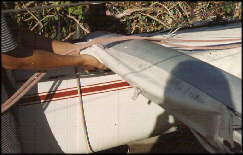 |
| ...then to the center of the crossbar. | 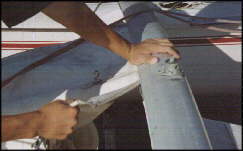 |
| Remove the covers from the castings. The screws were really locked in, so we had to use an impact tool to get them off. If you don't have one of these, you can find them at most tool outlets. (A good one will cost about $50. If you are going to use it on a rare basis, consider the cheaper foriegn models at $9). Basically, it's a screwdriver that you rap with a hammer. The impact drives the tool into the screw for traction, and turns it at the same time. | 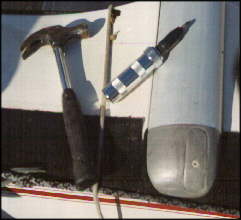
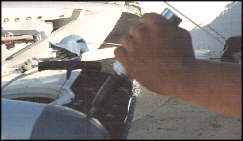 |
| In our case, the screws were frozen in so badly that the impact tool sheared the heads off, but the crossbar was being discarded anyway. (Check this out on a replacement crossbar before you buy it. You will want one with the screws either intact, completely removed, or have some idea as to how to get busted ones out.) |  |
| Remove the outboard bolts with a 9/16 inch socket and wrench. | 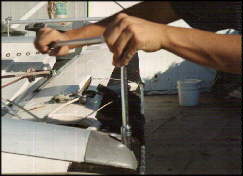 |
| Remove the inboard bolts with a 5/16 inch allen wrench. You will want 2 allen wrenches, so you and your assistant can each work on your own side. Since you will only get a half of a turn and have to reset the wrench a couple of hundred times, it is interesting to note which person begins to use foul language first. | 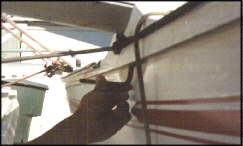 |
| With an assistant, remove the crossbar. | 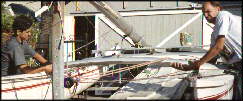 |
|
Install the new crossbar in the reverse order of removal, reinstall the trampoline, and
precamber the main beam.
If you need replacement bolts casting covers, you'll need 1 1/4" 10-24 stainless pan head bolts. These are available at most hardware stores.
Not all that dramatic really. And since Frank was not helping us, nobody had their hand cut off in the process. The important point here is that you can perform substantial repairs to an older boat at very little cost using used parts. Even more important is the value of good seamanship. Inspect your boat frequently and if the integrity of any part appears compromised, fix or replace it before taking the boat out again. Always maintain your boat in good condition. Your very life could depend upon it. Bill Mattson mattson@earthlink.net Back to Features |